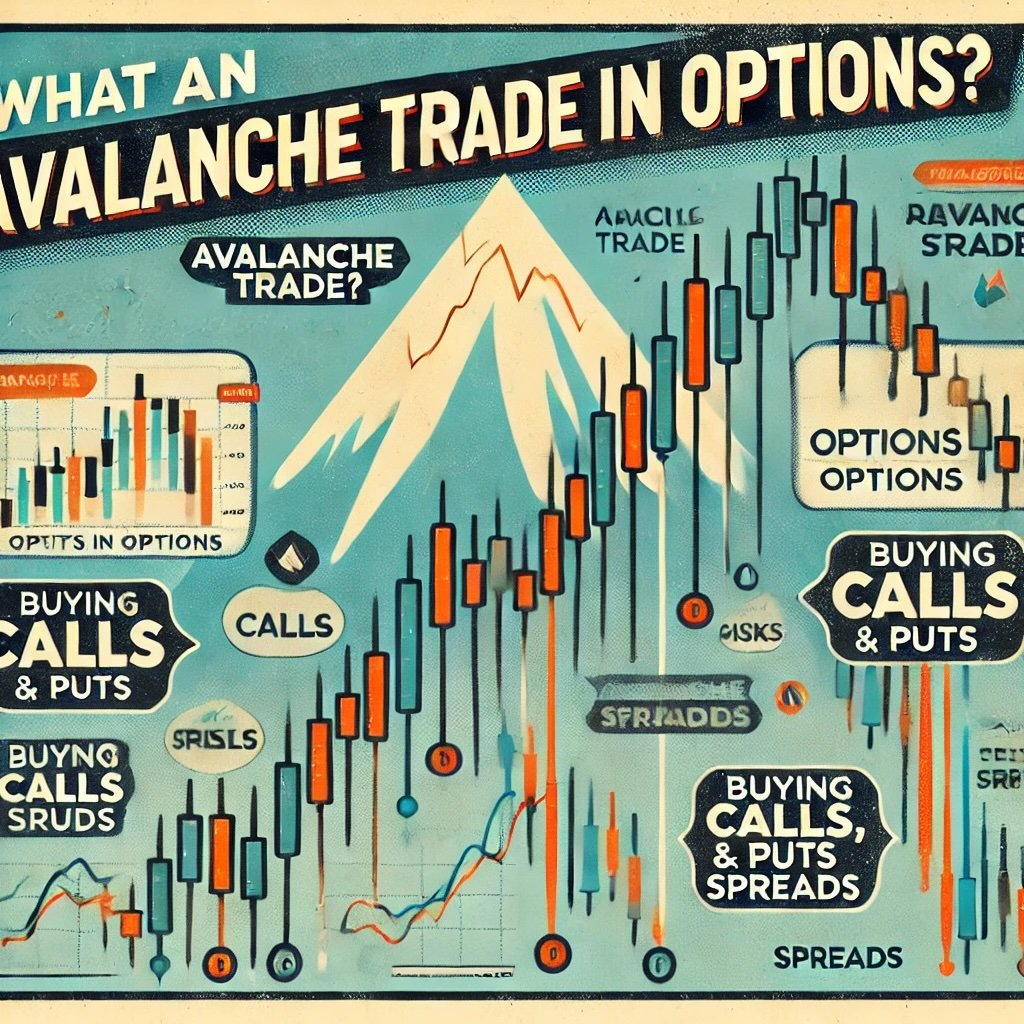Unpredictable weather is part of our daily news cycle: heat waves scorching vast regions, cold snaps paralyzing cities, hurricanes carving new paths, and unexpected droughts unsettling once-stable agricultural zones. Though the weather has always been mercurial, climate change and global warming have seemingly magnified these fluctuations, bringing fresh challenges and uncertainty to businesses worldwide. In this era of extremes, tools like weather derivatives have arisen as innovative solutions to mitigate financial risks associated with climatic swings.
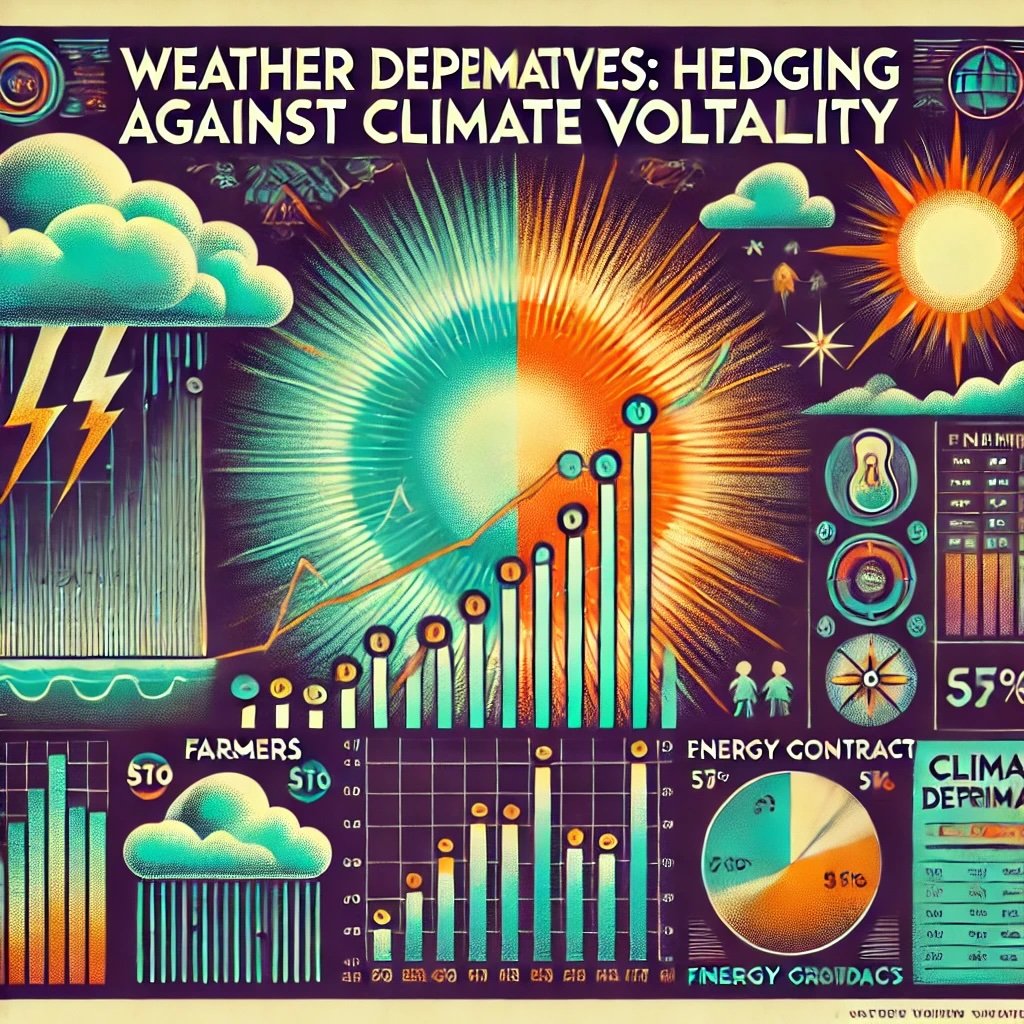
Imagine you run a resort in a sunny destination. You bank on warm, balmy weather to attract beach-loving tourists. If an unseasonably cool summer strikes, your occupancy rates could plummet, undermining revenue forecasts. Conversely, if you’re a farmer in a typically moist region that suddenly faces drought conditions, you may see your crop yields drop, resulting in unanticipated losses. Traditional insurance products might cover certain catastrophic events—but not necessarily the subtle (or not-so-subtle) shifts in temperature, rainfall, or snowfall that affect daily or seasonal business operations.
Purpose Of Weather Derivatives
This is where weather derivatives come into play. They provide a hedging mechanism to manage the financial impact of weather anomalies. Conceptually, they work a bit like other derivatives, with a reference index—in this case, weather data such as temperature or rainfall—and payouts triggered when that index exceeds or falls below predetermined thresholds. These instruments can be a godsend for energy companies grappling with variable heating or cooling demand, farmers coping with uncertain precipitation, theme parks banking on sunny days, and even event organizers who dread the possibility of a rained-out festival.
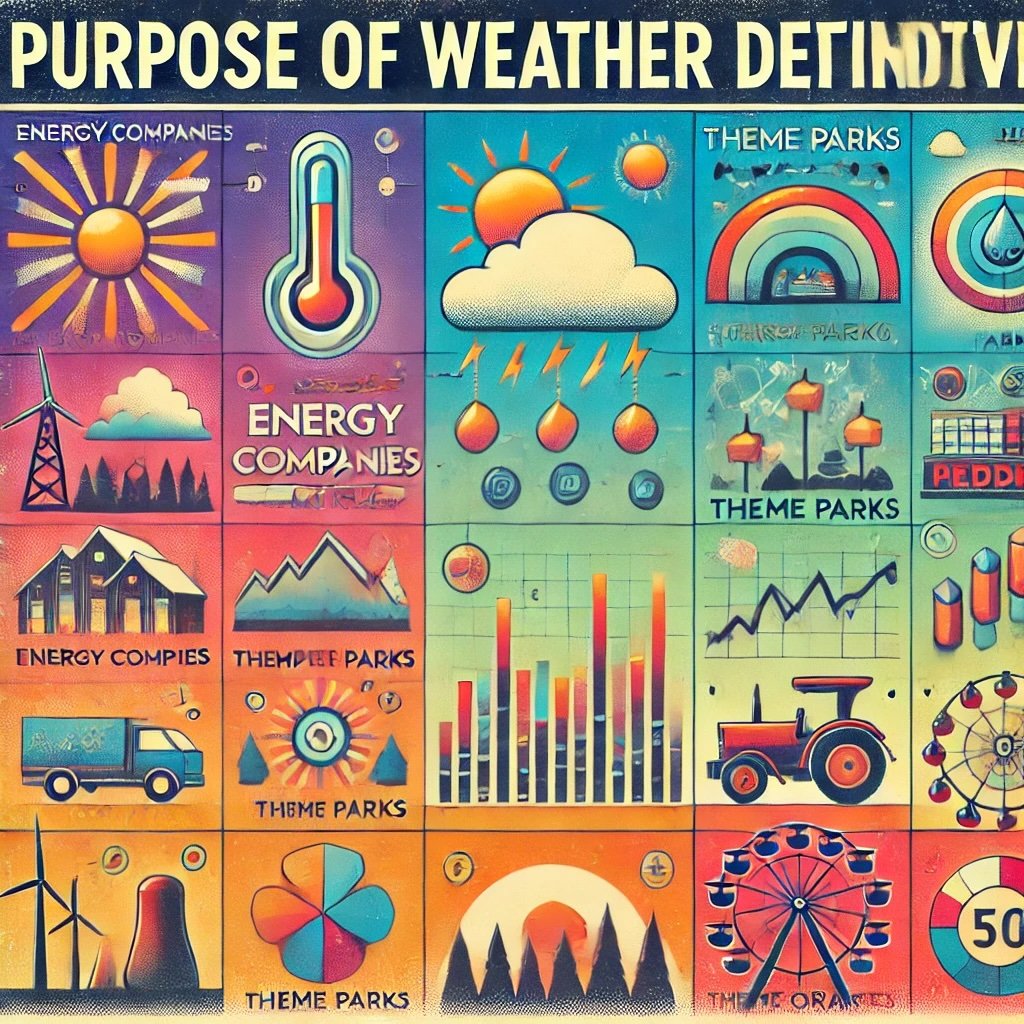
Why should we devote attention to such derivatives now? The truth is, as climate patterns become more erratic, weather risk intensifies. Beyond that, many industries find themselves increasingly sensitive to small changes in meteorological conditions. Retailers might see sales shift drastically if winter is milder than usual, while construction firms may face project delays if precipitation outstrips historical averages. Weather derivatives exist to cushion the blows of these unpredictabilities, turning what might be purely luck or misfortune into a manageable financial scenario.
Yet, these instruments are not without complexities. They demand accurate weather data, robust forecasting, and a decent understanding of how the business’s financial outcomes correlate with climatic variables. They also differ from conventional insurance in certain ways: rather than indemnifying specific damages, they settle based on triggers related to measurable weather indexes. This means you could receive a payout even if you don’t experience direct damage, or conversely, you might not get compensated if the defined weather metrics aren’t breached, even though you endured a negative outcome that wasn’t captured by the derivative’s structure.
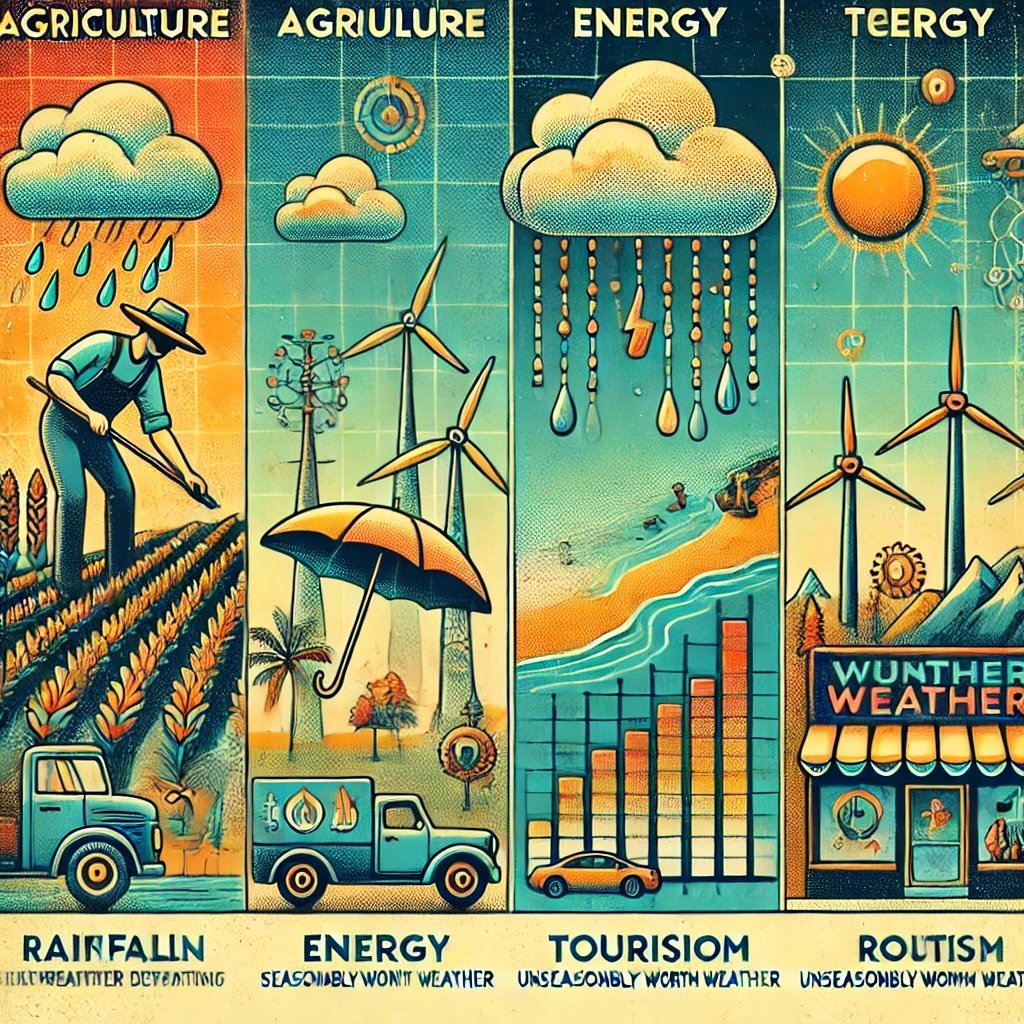
Understanding Weather Derivatives
What Are Weather Derivatives?
Weather derivatives are financial instruments that help hedge against the economic impact of weather fluctuations. They function somewhat like other derivatives—such as commodity futures or currency forwards—where an underlying index (like the price of a commodity) determines the payout. In this case, the underlying index is a weather variable, such as temperature, rainfall, snowfall, or even wind speed. The overarching goal is straightforward: when weather deviates from normal conditions in a manner that disrupts the buyer’s revenue model, the derivative pays out to offset those losses (or at least reduce their severity).
While both weather derivatives and insurance aim to mitigate risk, they aren’t identical. Insurance typically covers specific types of damage (e.g., property damage from storms) and often requires proof of that damage. Weather derivatives, in contrast, revolve around purely measurable weather data points. If your contract states you’ll receive $X if the monthly average temperature is below a certain threshold, you get that payout when the threshold is met, no matter if it directly caused damage or not. This parametric approach can be simpler for claims since it relies on objective weather data, removing the need for site inspections or damage assessments.

How They Work
Imagine a scenario: a ski resort enters a derivative that pays out if the total snowfall in January is less than 20 inches. The trigger is simple: measure the snowfall; if it’s below 20 inches, the resort collects a predetermined amount of money—offsetting some of the lost revenue from fewer visitors. Conversely, if the snowfall meets or exceeds that threshold, the resort collects nothing (and presumably doesn’t need it since business is presumably good).
The underlying data—snowfall in this example—could be verified by an official weather station in that region. Payment calculation is often linear or step-based. In a linear structure, the more the actual measure deviates from the agreed reference point, the larger the payout becomes. This format ensures direct correlation with your operational loss. For instance, each inch below 20 might translate into an incremental payout up to a maximum limit.
Who Uses Them?
Several industries find weather derivatives indispensable. A few examples:
- Agriculture: Farmers lock in compensation if a rainy season is uncommonly dry, or a cold spell arrives uncharacteristically early.
- Energy: Utilities might hedge against a mild winter that reduces heating demand or a cool summer that diminishes air conditioning usage.
- Tourism and Hospitality: Beach resorts or amusement parks might fear rainy summers; weather derivatives can help recoup potential revenue losses.
- Retail: Certain product lines—think winter apparel or barbecue supplies—are extremely sensitive to seasonal weather. If winter is oddly warm, coat sales might slump, so some retailers hedge with temperature-based contracts.
In each case, the business can remain financially stable despite suboptimal weather because the derivative payout compensates for shortfalls in revenue or extra operational costs. That stability fosters better planning and reduces catastrophic risk.
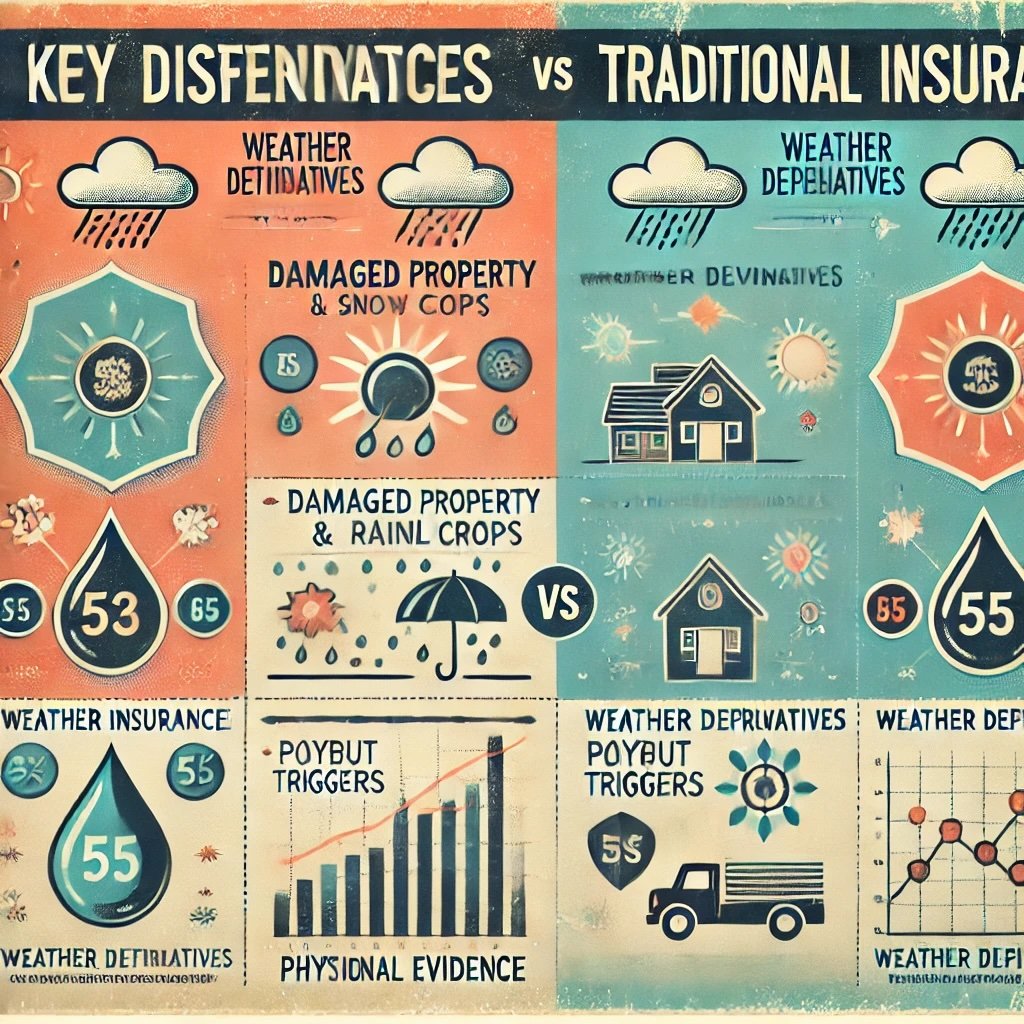
Key Distinctions from Insurance
Though they sound akin to insurance, weather derivatives aren’t exactly the same. Traditional insurance typically covers direct physical damage or liability—for instance, storms ravaging a building or crops. Weather derivatives revolve around the concept of “index-based” payouts: they rely on external data triggers, not physical evidence of harm. This distinction means you might receive a payoff from a derivative despite minimal actual harm if the weather index meets your contract’s condition, or you might get no payoff if the index remains outside your set triggers, even if your individual circumstances lead to some losses.
These derivatives also allow for a wider array of usage, including speculation. Hedge funds or traders might buy weather derivatives simply anticipating certain climatic patterns, hoping to profit from price movements. Companies, however, typically use them for risk management rather than speculation. The contract can be customized—covering temperature thresholds, rainfall measurements, or cumulative sun hours—providing flexibility beyond typical coverage in commercial insurance policies.
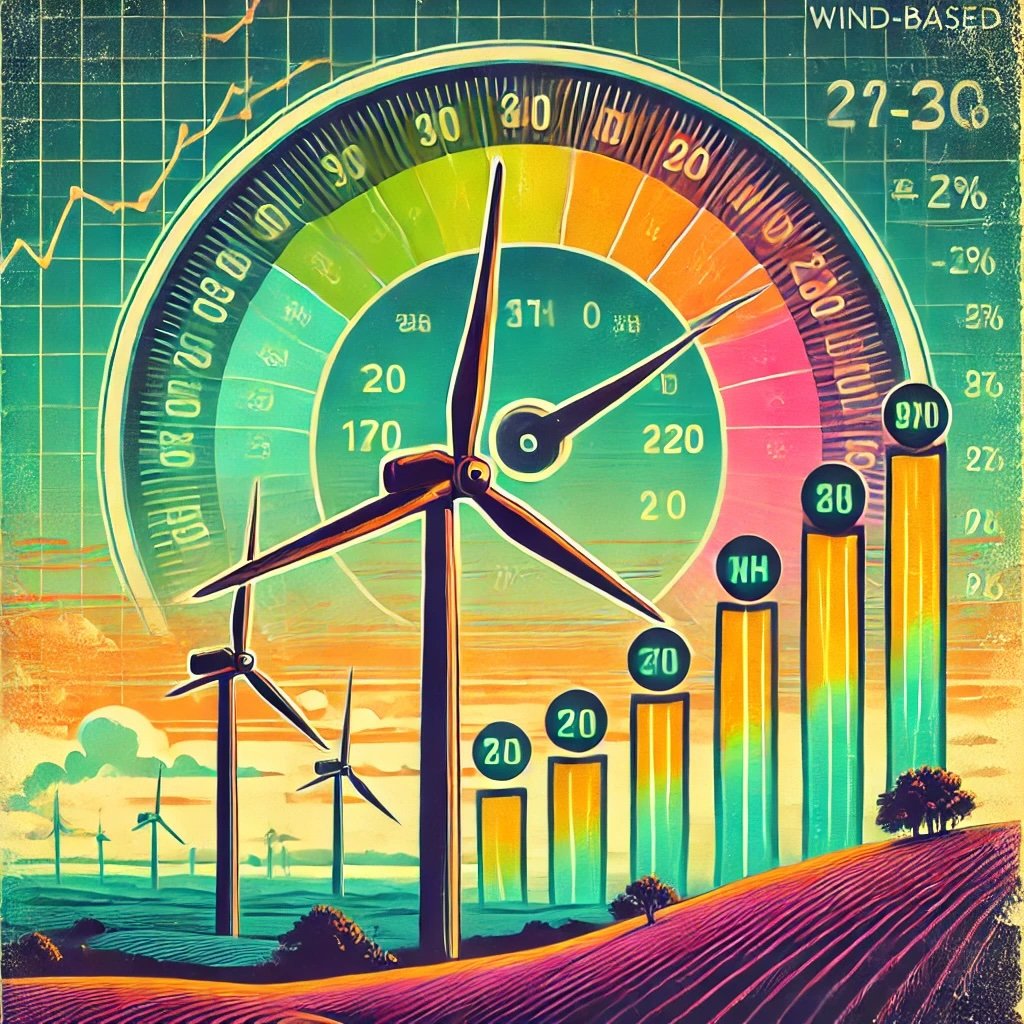
Types of Weather Derivatives
Weather derivatives come in multiple flavors, distinguished primarily by the weather variable each contract uses as its underlying index. Some revolve around temperature—the most common measure—while others tie to rainfall, snowfall, or wind patterns. The choice hinges on your industry and the specific risks you face. Below, we’ll outline the main categories, from widely used temperature-based contracts to more niche or customized arrangements.
Temperature-Based Derivatives
Temperature forms the backbone of many weather derivatives because so many businesses depend heavily on heating and cooling demand. To measure temperature, these derivatives often utilize “degree days” metrics:
- Heating Degree Days (HDD): These come into play when average daily temperatures fall below a baseline (commonly 65°F in the United States). Each degree below 65°F is an HDD. If you’re an energy supplier, a cold winter means more HDD, implying higher heating usage—and thus higher potential revenue. Conversely, a mild winter leads to fewer HDD, potentially slashing revenue. An HDD derivative could pay out if the total HDD for a season is below your threshold, compensating for lost sales.
- Cooling Degree Days (CDD): Opposite of HDD, CDDs measure how much hotter the day’s average temperature is compared to 65°F. Utility firms or businesses reliant on air conditioning usage—like hardware stores selling AC units—may find this measure relevant. If the summer is unusually cool and fewer people crank up their AC, a derivative paying out for low CDD might help offset that drop in demand.
Example: Let’s say a utility sets a contract for a summer period where if CDD is less than 500, they receive a lump sum. That sum might recoup the lost revenue from a cooler-than-expected season. If the CDD surpasses 500, the utility collects nothing because it presumably sells more electricity for air conditioning. This arrangement ensures financial stability in either scenario.
Precipitation-Based Derivatives
Precipitation-based contracts revolve around rain or snow totals. They can benefit industries like:
- Agriculture: Farmers reliant on sufficient rainfall (or dryness) can hedge against extremes that hamper crop yields.
- Construction: Extended rainfall can delay projects, incurring extra labor and equipment costs. A rainfall-linked derivative could cover such overruns.
- Event Planning: Outdoor events—music festivals, fairs—may face attendance drops if rain occurs on key days. A “rain day” contract might trigger a payout if rainfall exceeds a set threshold.
Specific triggers can revolve around daily rainfall, cumulative monthly rainfall, or the number of days with rain above a certain amount. Snow-based derivatives also exist— for instance, a ski resort might secure a contract paying out if the total snowfall remains below a particular level, covering lost ticket sales during a mild winter.
Wind-Based Derivatives
Wind-based derivatives are somewhat less common but have gained prominence, especially for renewable energy operators reliant on consistent wind flows. A wind farm, for instance, expects a certain wind speed range to optimize electricity output. If the wind is weaker than usual, power generation declines, translating to reduced revenue. A wind-based contract can pay out if average wind speeds (recorded at a local station or by verified equipment) are below a threshold.
Conversely, sometimes too much wind is detrimental—particularly for certain events or industries. The derivative can flip that coverage so that if wind speeds breach a high threshold, a payout compensates for potential operational shutdown or damage.
Customized Derivatives
Beyond these core categories, derivatives can be tailored to practically any weather index. For instance, a theme park might want a contract pegged to the number of “sunshine hours” in July, or an agricultural operation might specify contracts for soil moisture indices. Advances in data collection and modeling continue to expand the possibilities. Parametric insurance often overlaps with these structures, blending aspects of derivative payouts and more traditional coverage, driven by well-defined weather triggers.
Selecting the Right Type
Deciding which derivative to employ is a matter of assessing your primary weather vulnerability:
- If your biggest worry is cooling or heating demand, temperature-based HDD or CDD instruments likely suit you.
- If precipitation can ruin an event or hamper yields, a rainfall or snowfall option might be your saving grace.
- Renewable energy providers might cling to wind-based solutions, ensuring stable cash flow in the face of inconsistent breezes.
In each scenario, the contract’s design—thresholds, payout scale, and coverage duration—must align with the financial impact that unwelcome weather would cause. That’s why some businesses spend considerable time analyzing past weather data, zeroing in on the main metric that best correlates with their revenue or cost fluctuations.
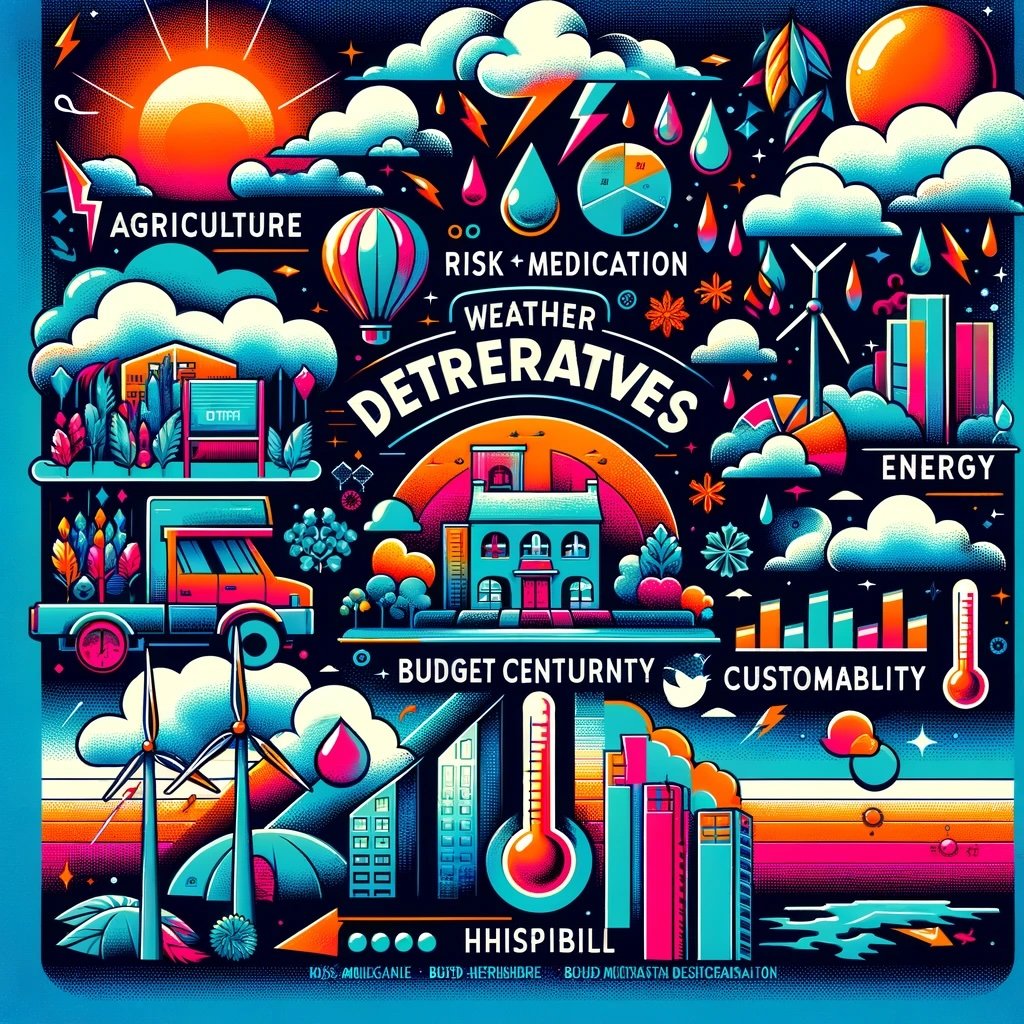
Benefits of Weather Derivatives
Weather derivatives fill a niche that conventional insurance products often neglect—namely, the financial fallout from weather extremes that don’t necessarily cause direct physical harm but still erode revenues or inflate costs. By bridging that gap, they bring multiple benefits to entities reliant on stable, predictable weather conditions. Let’s break down the key advantages.
Risk Mitigation
The foremost benefit is risk mitigation. Weather volatility can cripple budgets. A mild winter can cut heating demand for utilities; an unseasonably warm spring can shrink coat sales for apparel retailers. With a weather derivative, you hedge these vagaries. If the undesired climatic outcome materializes, you receive a payout to offset revenue losses.
This arrangement fosters financial resilience. Imagine a theme park operator who invests heavily in promotional campaigns for the spring season. If rainfall surpasses normal levels, fewer families visit. The operator’s derivative, triggered by excessive rainfall, pays a lumpsum. This revenue injection cushions the blow, preventing layoffs or last-minute budget cuts. The principle applies across industries, illustrating how weather derivatives provide a “safety net” for revenue unpredictability.
Enhanced Budget Certainty
Stable cash flow underpins sound business planning, from setting marketing budgets to scheduling expansions. Without a hedge against climate extremes, many firms must either build large cash reserves or accept significant quarterly earnings volatility. A well-tailored weather derivative effectively levels out your balance sheet from one season to the next, fortifying your short-term liquidity and long-term strategic planning.
For example, a water utility reliant on consistent precipitation levels might endure big swings in revenue if a drought forces rationing. By buying a rainfall-based derivative, they ensure that in a dryness scenario, the derivative helps top off any revenue shortfall. That predictability can calm investors, employees, and other stakeholders who rely on stable growth or consistent operational budgets.
Flexibility and Customization
Weather derivatives also outshine typical insurance policies in terms of flexibility. Where an insurance contract might specify certain “trigger events” (like a hurricane landfall) with strict definitions of damage, weather derivatives revolve around easily quantifiable indexes: temperature, rainfall, wind speed, etc. This parametric design means you can tailor triggers exactly. If your orchard gets hammered by unexpected frost, you might structure a contract to pay out when night temperatures dip below a particular threshold for multiple nights in a row.
In addition, contract durations can vary. You might want coverage for a specific three-month period that’s crucial to your operations, or for a single week tied to your biggest event of the year. You can also decide how payouts scale: a linear formula that increments for each degree below average, or a stepped approach that leaps significantly once a major threshold is breached. This versatility ensures you’re addressing the real financial pain points rather than buying a one-size-fits-all policy.
Broader Applications
Though agriculture and energy remain the most common users, the scope of weather derivatives extends widely:
- Retail: Chains that see demand fluctuate with temperature (e.g., heavy jackets, grills, seasonal beverages).
- Event Planning: Concerts, outdoor festivals, sports leagues with big stakes in meteorological outcomes.
- Hospitality: Hotels and resorts banking on sunshine or mild conditions to entice visitors.
- Construction: Projects delayed by rainfall or extreme cold can reduce profitability, so derivatives can stabilize budgets.
For each segment, the fundamental logic remains consistent: if certain climate outcomes lead to monetary loss or inflated costs, a carefully structured derivative can cushion that impact.
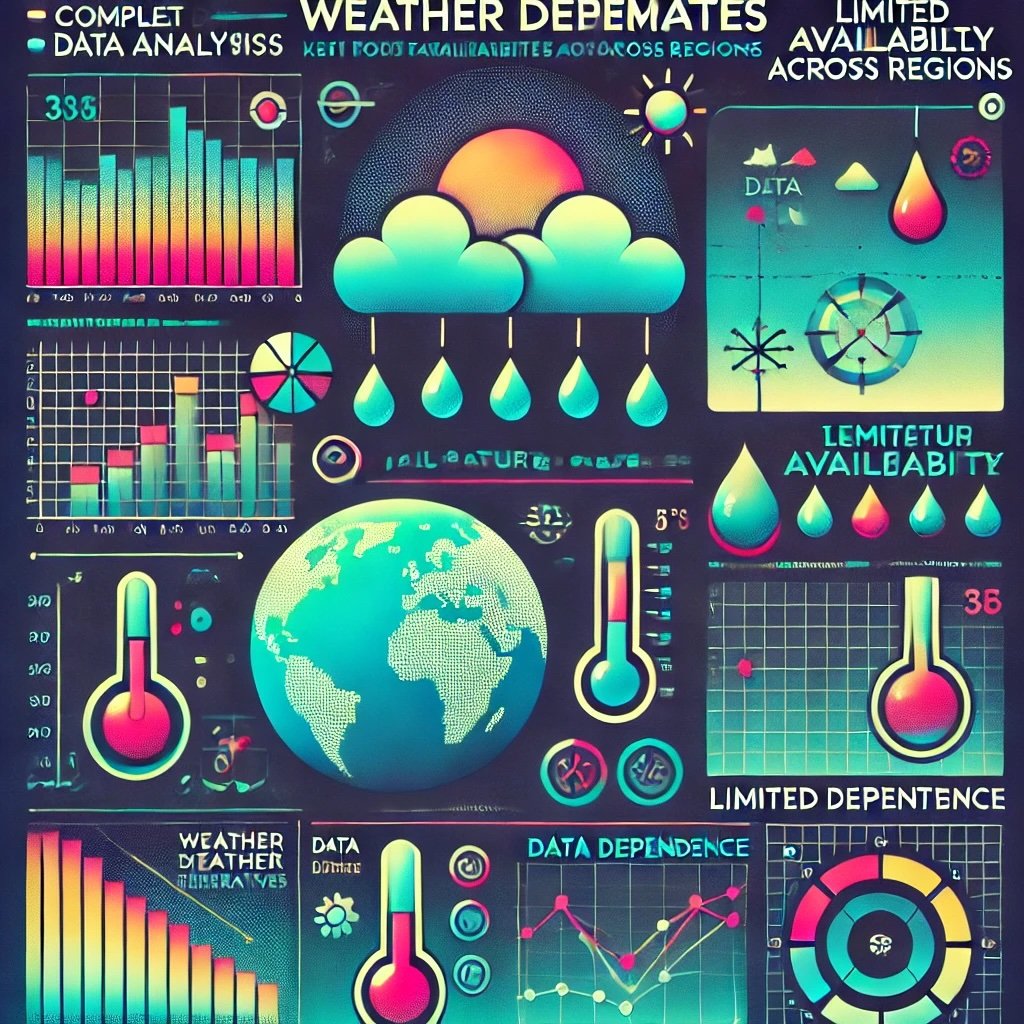
Challenges and Limitations
No financial tool, however creative or beneficial, is flawless. Weather derivatives, in all their parametric elegance, can also stumble if they’re misapplied or misunderstood. Before rushing to adopt them, it’s prudent to weigh the challenges and limitations that come with these instruments.
Complexity
One frequent hurdle is the complexity in creating and maintaining weather derivative contracts. At a high level, the concept is simple: choose a weather metric, set thresholds, define payouts. But in reality, calibrating these elements demands a nuanced understanding of both your business’s weather sensitivity and the data used to measure that weather factor. For instance, how do you decide whether to track daily average temperature, daily high temperature, or cumulative rainfall? If the chosen measure doesn’t precisely match how your business is affected, the hedge may only partially cover your risk.
Additionally, analyzing historical weather data can be time-consuming. You might sift through decades of records to pinpoint how temperature fluctuations historically impacted your profits. If your business is quite localized—like a single vineyard or resort—ensuring that local meteorological data is both reliable and consistent can be challenging. And for certain microclimates, the nearest official station might be miles away, potentially diminishing the contract’s accuracy in reflecting your local conditions.
Limited Availability
Though the concept of weather derivatives has existed for some time, the market isn’t uniformly mature across the globe. In places like the United States or parts of Europe, there’s a relatively well-developed network of weather derivative offerings, exchanges, and brokers who facilitate these contracts. Elsewhere, especially in emerging or less developed markets, you may struggle to find off-the-shelf solutions or local data that meets the rigorous standards necessary for contract settlement.
That limitation might prompt businesses to rely on over-the-counter (OTC) deals or specialized brokers who can structure custom derivatives. But such customized solutions can be more expensive, less transparent, and heavily dependent on trusting your counterparty’s creditworthiness. Without a broad marketplace, the liquidity might be low, meaning it’s harder to enter or exit positions or to get fair pricing.
Data Dependence
Weather derivatives revolve around objective data triggers, which is both a feature and a vulnerability. If the underlying weather station or data source is flawed, your contract’s reliability suffers. Suppose the station experiences calibration errors or faulty sensors. Potential disputes may arise if data is retroactively corrected or if a sensor malfunction means no data was recorded for a critical period. That risk is typically lower in well-established markets with robust meteorological infrastructure, but it can’t be dismissed entirely.
Moreover, the reliance on historical records for pricing can be tricky in an era where climate patterns are changing. If the historical data from 30 years suggests certain temperature norms, but current trends shift more drastically, your derivative might be mispriced. You might pay too much (or receive too little) for coverage that doesn’t align with evolving climate realities.
Speculative Risks
As with any derivative, there’s a speculative angle. You could end up paying premiums for coverage that never triggers if the weather stays within normal ranges. Alternatively, if you’re a buyer banking on a severe weather event, and it fails to occur, your premium outlay is essentially lost. Some investors even approach weather derivatives purely for speculation, hoping to profit from predicted anomalies in temperature or rainfall. While that’s not typically the primary use, it can influence the market’s pricing dynamics.
Finally, emotional or ill-informed usage can lead to suboptimal outcomes. For instance, an agribusiness might jump on a rainfall derivative when they actually needed a temperature-based one, or they might set thresholds improperly. Over time, poor design can result in repeated mismatch between contract payouts and actual financial losses.
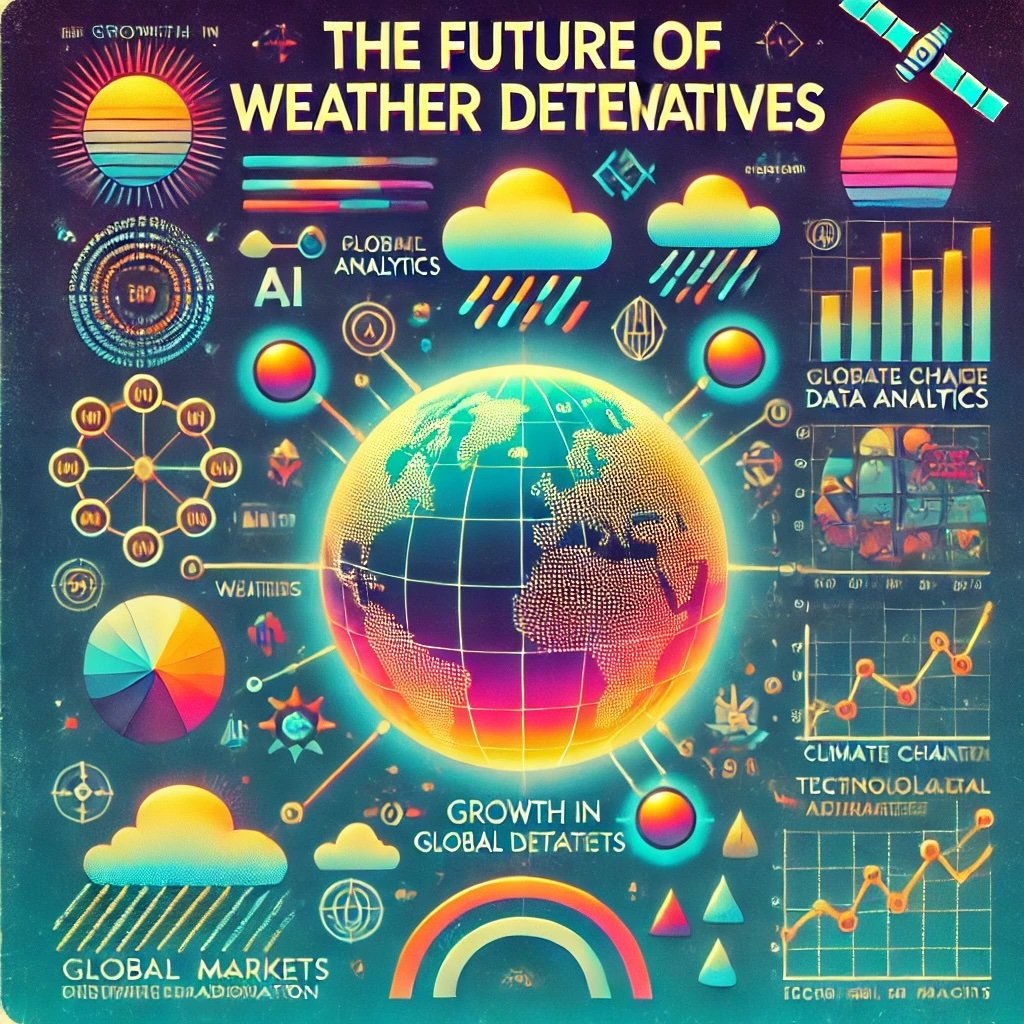
The Future of Weather Derivatives
The prospect of more frequent and severe weather events has sparked a growing demand for risk mitigation solutions. Weather derivatives stand poised for expansion, evolving in tandem with breakthroughs in data analytics, artificial intelligence (AI), and climatic research. Let’s explore where this domain is headed, the potential for market expansion, and how these instruments might integrate with broader ESG (Environmental, Social, Governance) initiatives.
Growing Importance with Climate Change
As greenhouse gas emissions continue, many scientists forecast an uptick in climate volatility—extreme temperatures, shifting precipitation patterns, intensifying storms. For businesses that rely on stable weather to operate smoothly, these changes present existential risks. Agriculture might see yield unpredictability, energy demand might gyrate with unseasonable cold or heat, and coastal tourism might suffer from more frequent storms. Weather derivatives, by offering a mechanism to offset unexpected financial impacts, are naturally poised to gain traction.
While initially overshadowed by simpler risk management tools, weather derivatives fit neatly into modern risk portfolios. Demand for these specialized hedges will likely climb, especially in vulnerable regions—like parts of Asia, Africa, or Latin America, where agricultural sectors face ever more pressing climate threats but historically lacked advanced hedging solutions. Institutions such as the World Bank have already piloted parametric insurance for natural disasters in some developing nations. An expansion into more refined weather derivative offerings could follow suit.
Technology Advancements
Big data and artificial intelligence can substantially enhance weather derivative markets. Until now, many participants relied on historical records from official meteorological agencies. In the near future, hyper-local sensors, satellite imagery, drone-based climate readings, and sophisticated forecasting models could feed more granular, real-time data into derivative pricing. This improved data environment not only refines the accuracy of existing contracts but might yield brand-new contract types. For instance, a city-wide sensor network might record block-by-block rainfall levels, enabling ultra-local derivatives for small businesses reliant on foot traffic.
AI or machine learning can also augment the design process. Instead of manually guessing thresholds or payout curves, algorithms can propose contract structures that best mirror a firm’s historical weather-revenue correlation. This approach can reduce guesswork, improving the alignment between payout triggers and real economic impacts. In tandem, blockchain or smart contract platforms might expedite settlement processes, removing the friction of verifying weather data and disbursing funds.
Market Expansion
Historically, the U.S. and parts of Europe host the lion’s share of weather derivative transactions. But as climate-related threats deepen globally, one can foresee new markets popping up in Asia-Pacific or parts of Latin America. For example, small-scale farmers in India might soon access cooperative-based or government-facilitated derivatives covering monsoon rainfall. Similarly, solar or wind farms in Africa might hedge inconsistent wind or sunlight hours with standardized or bespoke contracts. Overcoming these logistical and regulatory barriers will hinge on collaborative efforts between governments, insurers, data providers, and financial institutions.
Moreover, the principles behind weather derivatives can branch out. Some parametric products now hedge against wildfire spread or extreme storm surges. While these aren’t strictly “weather derivatives,” the impetus is similar: harness data from satellites or ground sensors to produce an index-based payout, bridging the gap between intangible, climate-induced losses and financial stability.
Integration with ESG Goals
Another frontier is merging weather derivatives with ESG imperatives. As companies strive to demonstrate environmental stewardship and resilience, adopting robust risk management tools that address climate uncertainty can bolster their ESG credentials. For instance, a major agribusiness that invests in parametric solutions might underscore its commitment to safeguarding local communities and food supply chains. Meanwhile, renewable energy projects can illustrate financial resilience by hedging wind or solar variability, reassuring investors who weigh climate risk heavily in their decisions.
Additionally, some green finance frameworks might incorporate weather derivatives. Imagine a situation where a city invests in a “climate adaptation bond,” partially backed by a derivative that triggers if certain climate thresholds are breached. The city, then, can channel payouts into infrastructural improvements. Such linkages between public finance and parametric products highlight the potential synergy between financial innovation and climate resilience.
The Next Chapter
In essence, the expanding challenges of climate volatility ensure that weather derivatives remain relevant—and likely become increasingly sophisticated. While the fundamentals—index-based triggers and payout structures—stay intact, data improvements, international adoption, and connections to ESG could spur new contract types and deeper liquidity in this market. As climate unpredictability intensifies, these instruments might shift from niche to mainstream, forming part of a standard toolkit for risk-conscious entities.
Of course, none of this erases the complexities or the inherent speculation involved. Participants must continue refining these products to ensure they truly mitigate real-world weather risk, rather than just offering a veneer of coverage. But for those prepared to navigate the complexities, the evolving landscape of weather derivatives promises fresh opportunities for hedging and growth.
Final Thoughts
Thus, weather derivatives aren’t a cure-all. They demand thorough knowledge of your operational vulnerabilities, plus reliable meteorological data. Misconfigurations—say, setting an irrelevant weather threshold—could render a contract useless or mismatched. Another point of caution: even a well-designed derivative cannot forestall deeper structural disruptions if climate changes morph beyond historical patterns. If average rainfall data from the last half-century no longer mirrors today’s reality, a contract pegged to that old data could prove insufficient.
Regardless, for numerous businesses, from orchard owners to winter gear retailers, these derivatives fill a vital gap between traditional insurance coverage and real-world climatic risk. If you decide to incorporate them into your risk management strategy, or you’re an investor eyeing this space for innovative financial products, know that success hinges on combining robust forecasts, a solid grasp of your revenue-weather link, and a structured approach to contract design.
Finally, weather derivatives exemplify how modern finance can adapt to evolving global challenges. The idea that intangible forces like temperature or wind can anchor financial transactions once seemed far-fetched. Yet, as we all face more erratic weather, it’s precisely these creative, data-driven hedges that may offer the stability businesses need to ensure continuity. Just as one invests in diversification for their portfolio’s benefit, investing in a weather derivative can fortify your operations against the swirling, ever-shifting patterns of the climate overhead—yielding not just better risk management, but peace of mind in a world increasingly dominated by weather headlines.
Weather Derivatives: 12-Question FAQ
What is a weather derivative in plain English?
A weather derivative is a financial contract that pays out based on a measured weather index—like temperature, rainfall, snowfall, or wind—rather than on physical damage. If the weather crosses a preset threshold (the “trigger”), the buyer receives a payout that helps offset revenue shortfalls or extra costs caused by adverse conditions.
How do weather derivatives differ from traditional insurance?
Insurance indemnifies specific losses after damage is proven (e.g., hail destroying crops). Weather derivatives are parametric: they pay when an objective index is breached, regardless of whether you suffered inspectable damage. This can speed up settlement and reduce disputes, but also introduces basis risk if the index doesn’t perfectly mirror your actual losses.
What indices are most common (HDD, CDD, rain, snow, wind)?
Temperature dominates via:
Heating Degree Days (HDD): cold exposure vs. a base (often 65°F/18°C).
Cooling Degree Days (CDD): heat exposure vs. the same base.
Other indices include cumulative rainfall/snowfall over a period, number of rainy days above a threshold, wind speed averages, and sunshine hours—chosen to match a business’s key weather sensitivity.
Who uses weather derivatives in practice?
Energy & Utilities: hedge mild winters/cool summers that dent gas/electricity demand.
Agriculture: hedge drought/over-rain or poorly timed frost.
Tourism & Hospitality / Events: hedge rainy or unseasonable periods that reduce attendance.
Retail & CPG: hedge temperature-driven demand swings (e.g., coats, beverages, grills).
Construction & Infrastructure: hedge delays/cost overruns tied to precipitation or cold snaps.
How are payouts calculated and settled?
Contracts specify: (1) the measurement site/data source (e.g., a named weather station), (2) the observation window (dates), (3) the trigger and payout formula (linear or step-based), and (4) a cap. Settlement uses verified readings from the agreed source; no adjuster visit is required, which accelerates payment.
What is “basis risk,” and how do I reduce it?
Basis risk is the mismatch between your actual financial loss and the index-based payout. Reduce it by:
Selecting the closest, highest-quality station (or blended stations).
Picking the right variable and threshold (e.g., HDD vs. daily min temperature).
Using granular observation windows aligned to your revenue season.
Considering multi-trigger or tiered structures to better fit your exposure.
How are these instruments priced?
Pricing blends historical weather distributions, forward forecasts, market supply/demand, and counterparty credit. More volatile climates, longer coverage windows, tighter caps, and deeper in-the-money triggers generally cost more. Custom OTC structures often reflect bespoke modeling and thus command higher pricing than standardized exchange products.
Where do I buy them—exchange or OTC?
Exchange-traded: Standardized futures/options (historically at venues like CME) on HDD/CDD for select locations and months; transparent pricing but limited customization.
OTC (over-the-counter): Banks, specialty brokers, and reinsurers offer tailored contracts (variables, triggers, windows, stations). OTC maximizes fit but adds negotiation and counterparty considerations.
What data sources are acceptable, and what if sensors fail?
Parties pre-agree a primary data source (e.g., national meteorological agency station) and a fallback (backup station or reanalysis feed) plus rules for missing data and sensor errors. High-stakes programs sometimes include data audits, sensor maintenance clauses, or blended indices to improve robustness.
How do weather derivatives appear in accounting and risk policy?
Treatment varies by jurisdiction and contract form, but many firms treat them as hedging derivatives with mark-to-market accounting and hedge documentation under applicable standards. Finance/risk teams typically integrate them into the broader ERM and treasury policy alongside insurance, caps, and commodity hedges—often with board-approved limits.
What are the biggest pitfalls to avoid?
Choosing the wrong metric (e.g., total rainfall when the business is sensitive to rain timing).
Station too far from operations or with poor data history.
Observation windows that miss your true revenue season.
Over- or under-hedging because caps/limits don’t match worst-case scenarios.
Forgetting transaction costs, margining, and credit terms in ROI math.
How do I design my first hedge (simple checklist)?
Map revenue vs. weather (5–10 years of data).
Pick the dominant driver (HDD/CDD, rain, snow, wind) and window.
Quantify loss-per-unit-of-weather to shape linear or tiered payouts.
Select station(s) and fallback data rules.
Compare OTC vs. exchange quotes; evaluate pricing, liquidity, credit.
Set caps, counterparty limits, and accounting/hedge docs.
Post-season: back-test performance and refine.
Important Information
Comprehensive Investment Disclaimer:
All content provided on this website (including but not limited to portfolio ideas, fund analyses, investment strategies, commentary on market conditions, and discussions regarding leverage) is strictly for educational, informational, and illustrative purposes only. The information does not constitute financial, investment, tax, accounting, or legal advice. Opinions, strategies, and ideas presented herein represent personal perspectives, are based on independent research and publicly available information, and do not necessarily reflect the views or official positions of any third-party organizations, institutions, or affiliates.
Investing in financial markets inherently carries substantial risks, including but not limited to market volatility, economic uncertainties, geopolitical developments, and liquidity risks. You must be fully aware that there is always the potential for partial or total loss of your principal investment. Additionally, the use of leverage or leveraged financial products significantly increases risk exposure by amplifying both potential gains and potential losses, and thus is not appropriate or advisable for all investors. Using leverage may result in losing more than your initial invested capital, incurring margin calls, experiencing substantial interest costs, or suffering severe financial distress.
Past performance indicators, including historical data, backtesting results, and hypothetical scenarios, should never be viewed as guarantees or reliable predictions of future performance. Any examples provided are purely hypothetical and intended only for illustration purposes. Performance benchmarks, such as market indexes mentioned on this site, are theoretical and are not directly investable. While diligent efforts are made to provide accurate and current information, “Picture Perfect Portfolios” does not warrant, represent, or guarantee the accuracy, completeness, or timeliness of any information provided. Errors, inaccuracies, or outdated information may exist.
Users of this website are strongly encouraged to independently verify all information, conduct comprehensive research and due diligence, and engage with qualified financial, investment, tax, or legal professionals before making any investment or financial decisions. The responsibility for making informed investment decisions rests entirely with the individual. “Picture Perfect Portfolios” explicitly disclaims all liability for any direct, indirect, incidental, special, consequential, or other losses or damages incurred, financial or otherwise, arising out of reliance upon, or use of, any content or information presented on this website.
By accessing, reading, and utilizing the content on this website, you expressly acknowledge, understand, accept, and agree to abide by these terms and conditions. Please consult the full and detailed disclaimer available elsewhere on this website for further clarification and additional important disclosures. Read the complete disclaimer here.

